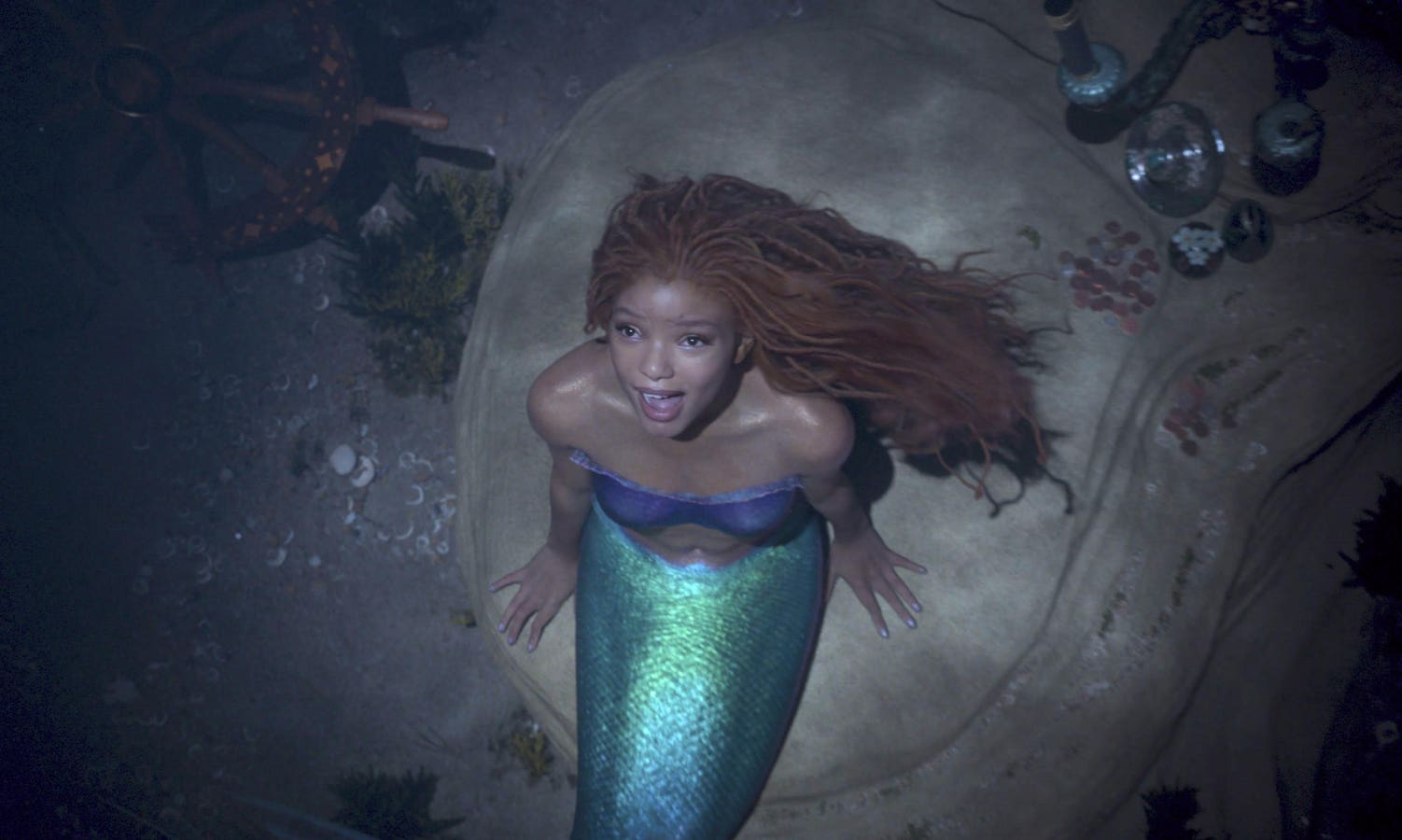Disney’s live action version of The Little Mermaid lost an estimated $4.9 million at the box office last year according to analysis of recently-released filings which reveal that the movie’s “cost exceeded the production budget” as spending surged to $355.1 million (£270.6 million).
The movie is a remake of Disney’s beloved 1989 cartoon which won two Academy Awards for its score and its catchy song ‘Under the Sea’. The remake stars Halle Bailey in the title role alongside a cast of computer-generated characters which contributed to the movie’s colossal cost.
The latest filings cover the year to August 31, 2023 which is three months after the movie was released and long after filming wrapped in July 2021. The year before release is when intensive work on visual effects is usually done and the financial statements show that $35.4 million (£27 million) was spent on the movie during the period. It didn’t pay off as The Little Mermaid was widely criticized for the eerie appearance of the creatures which inhabit its undersea world.
They were created by British visual effects firm Framestore and it had big boots to fill. The cuteness of the characters in the animated original is one of the reasons why it became a fan favorite whilst their computer-generated counterparts put off many viewers.
“There’s something about these depictions that triggers an uneasy response,” wrote Vox. “Maybe it’s the prolonged, lingering shots on their ‘smiling’ faces or that their tiny mouths are contorted in unnatural ways. It’s as though there’s almost something sinister hiding underneath the computerized animal skin – and that’s even before they start singing and dancing.”
It contributed to the movie scoring a critics’ score of just 67% on review aggregator Rotten Tomatoes. The audience was more complimentary and awarded it 94% though this didn’t translate into a blockbuster performance.
According to Disney it grossed “$570 million at the global box office” which was respectable but a far cry from the $1.7 billion haul of its live action version of The Lion King in 2019 and the $1 billion that Aladdin made in the same year.
It is widely accepted that studios receive around half of the theater takings with exhibitors retaining the remainder and this is supported by analysis from film industry consultant Stephen Follows. He interviewed 1,235 film professionals in 2014 and concluded that, according to studios, theaters keep 49% of the takings on average. It gives Disney an estimated $285 million from The Little Mermaid which is a drop in the ocean as the movie’s outlandish effects came at quite a cost.
Movie budgets are usually a closely-guarded secret because studios’ financial statements typically combine the costs of all of their productions without itemizing how much was spent on each one. Movies filmed in the United Kingdom are an exception and The Little Mermaid was one of them.
Studios film in the UK to benefit from the government’s Audio-Visual Expenditure Credit (AVEC) which gives them a cash reimbursement of up to 25.5% of the money they spend in the country.
To qualify for the reimbursement, at least 10% of core production costs need to relate to activities in the UK. In order to demonstrate this to the government, studios tend to set up a separate production company in the UK for each movie they make there. They have to file publicly-available financial statements which shine a spotlight on precisely how much it costs to make each picture. The filings show everything from the headcount and salaries to the total costs and the level of cash reimbursement.
The companies usually have code names so that they don’t raise attention with fans when filing for permits to film on location. The Little Mermaid was made by Disney’s subsidiary Sand Castle Pictures and its financial statements shine a spotlight on the windfall from the UK government as well as the $355.1 million that it cost to make the movie.
It blows the movie’s estimated budget out of the water. Deadline claimed that The Little Mermaid had a “$250m production cost” and there is good reason why it sailed past it.
Filming was reportedly due to begin in the UK between late March and early April 2020 but was repeatedly delayed by the pandemic. It eventually got underway in January 2021 at Pinewood Studios, just outside London, but was temporarily halted six months later due to multiple crew members catching COVID-19. The filings state that the budget overrun was “primarily due to the COVID-19 impact” and they also reveal the tricks that Disney had up its sleeve to combat it.
The first was the cash reimbursement which came to $65.2 million (£49.7 million), bringing the movie’s net costs down to $289.9 million. Deducting that from Disney’s $285 million share of the theater takings gives the movie’s result at the box office which was a $4.9 million loss.
The share of the box office isn’t the studio’s only return from a movie so offsetting it from the costs in the financial statements does not show whether it made a profit or a loss overall. “There will be other income generated by the production (such as DVD/Blu Ray sales, merchandising, etc.). It’s not reflecting a true account of whether the film was overall profitable,” says a Disney spokesman.
However, the financial statements also do not show the marketing costs of the movie so if the home entertainment and merchandise sales should be added on to the theater takings, the marketing cost should be deducted from them. Disney doesn’t disclose its marketing spend per movie, or the revenue from home entertainment and merchandise generated by each picture, so this can only be estimated which yields an unreliable result.
According to Disney, The Little Mermaid has been hugely popular on its Disney+ streaming platform with 16 million views in its first five days alone. However, it isn’t possible to state precisely how much subscription revenue the platform generates as Disney only discloses the total made by its Direct To Consumer (DTC) business, which includes Hulu and ESPN+ as well as Disney+.
Investors have hungered for a more in-depth look and got a brief glimpse recently thanks to a data leak reported by the Wall Street Journal. It claimed that internal spreadsheets suggest Disney+ generated more than $2.4 billion of revenue in the quarter to March 30, 2024, amounting to about 43% of its DTC division. Disney has been contacted for comment on the Journal’s report and any response will be inserted in an update.
Even Disney can’t tell how much of this revenue was generated by The Little Mermaid, or any specific movie, during that period, or any period, as subscribers to Disney+ don’t pay per film. They are billed monthly or annually and get access to a studio’s entire library, along with any new content released during their subscription period. This means it isn’t possible to attribute subscriber fees to specific productions without making an estimate, which again would be highly unreliable.
In contrast, the $4.9 million loss at the box office is calculated purely using data from Disney. The $355.1 million production costs of the movie come from its filings and so does the $65.2 million cash reimbursement whilst the $570 million box office total is contained in Disney’s press releases. However, it doesn’t stop there.
All of these components relate directly to the production process of any movie made in the UK but The Little Mermaid also got a helping hand due to its timing. The filings add that its income was topped up with $12.9 million (£9.8 million) of other operating income, including a $4.2 million (£3.2 million) grant from the UK government in 2021 to help it deal with the effect of the pandemic.
This pushed the picture back into the black, but not thanks to its performance in theaters or due to a reduction in its costs. Addressing both of these points is the only way to be sure that a movie will make a profit and it hasn’t escaped the attention of Disney’s chief executive Bob Iger. It explains why he said last year that the studio needs to “reduce costs on everything that we make because, while we’re extremely proud of what’s on the screen, it’s gotten to a point where it’s extraordinarily expensive.” The Little Mermaid is proof of that.
Read the full article here





